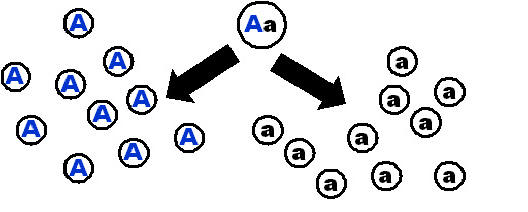
Mendelian Principles - Segregation
Mendel decided that his results were consistent with particulate inheritance. That is, for each trait there were underlying "particles" which were passed intact to the progeny. Such "particles" we now call genes. Based on binomial theory, Mendel decided that each individual organism had 2 particles (two genes) in its genotype. Alternate forms of these particles (which we now call alleles) could be designated as A and a (a designation that we still use today).
Each pea plant had two particles (alleles). When that individual pea plant made gametes (pollen or ovules), each gamete got one and only one of the two possible alleles.
The life cycle of plants (and of many organisms) from the point of view of the genes can be briefly summarized as:
two particles - one particles - two particles or
two alleles - one allele - two alleles or
diploid - haploid - diploid.
That is, an organism with two alleles makes a gamete with one allele (egg or sperm). When one gamete fertilizes another gamete, a new organism (a child or progeny) with two alleles is created.
The point is most easily illustrated in a heterozygous individual. A heterozygous individual has two different alleles. Therefore it would have the genotype Aa.

An individual with the genotype Aa can make two types of gametes: A and a. Since this is a random process, the individual will, on average, make equal numbers of each gamete. (Frequency of 1/2 for each gamete).
A second individual with genotype Aa can make two types of gametes: A and a. Since this is a random process, the individual will, on average, make equal numbers of each gamete. (Frequency of 1/2 for each gamete).
If these two individual mate, their gametes combine at random to make the next generation of diploid individuals. This mating produces four different progeny: AA, Aa, Aa, and aa, each with a frequency of 1/4.
Ignoring whether a particular gamete comes from the mother or the father, this cross produced three genotypes AA, Aa and aa in the proportions of 1/4:1/2:1/4 (or in a 1:2:1 ratio).
| Mother's Gametes |
Father' Gametes | ||
| A(1/2) | a(1/2) | ||
| A (1/2) | AA(1/4) | Aa(1/4) | |
| a(1/2) | Aa(1/4) | aa(1/4) | |
These observations led to the definition of Mendel's Principle of Segregation:
During the process of sex cell formation (that is, gametes) in any individual, the members of a pair of alleles go into separate gametes ( segregate) ;
Such gametes are formed in equal frequencies.
Subsequent fertilization is at random.
Segregation applies only to the alleles for a single gene. The process of segregation encompasses the formation of gametes and subsequent fertilization of an egg by a sperm to create a diploid zygote.